Many of us in the utility industry are forward thinkers. Providing a service that is expected to be instantly available through a system, which must last for decades, requires some forward thinking. For those new to the industry, take a moment to consider this quote – “The economic health of an electric utility is highly susceptible to changes in economic, social and living patterns of the community. It will be necessary for utilities to take new risks and assume unfamiliar roles in the public arena.” This quote was from the 1969 Power Systems Conference presentation given by J. W. Simpson, president of Westinghouse.
As we fast forward to 2011, our leadership at KCP&L embraces the same spirit. KCP&L strives to improve life in the communities it serves. This goal permeates everything the company and its employees do. So when we were approached by Google to partner with them to help build a newer, faster Internet service, we thought it was another great opportunity to improve life in the communities in which we live and work. This Internet service, called Google Fiber is expected to be available through a system that will be built using KCP&L’s existing infrastructure. Google has said Google Fiber will bring ultra high-speed fiber optic Internet service at one gigabit per second to the Kansas City, Mo. After months of positive collaboration and planning, the world now knows about the “Googlization” of Kansas City. Through this unique agreement, KCP&L will provide access to our electrical infrastructure for Google to install its fiber. In turn, Google will be able to offer Internet service at speeds up to 100 times faster than what most people have today.
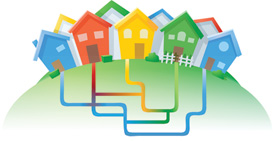
Embracing the Future
This agreement is not just an agreement between two companies; it opens the door to a multi-path superhighway to the future. You may have seen some recent articles about data overload, latency and buffering frustrations. These are issues that are becoming commonplace and will only get worse. As systems keep progressing, we need to be able to adapt. For example 3G-to-4G advancement is now mainstream in the telecommunications industry. Similarly, now is Kansas City’s chance to embrace this technology and the future of the Internet in one quantum leap. This is exciting for the region and motivating for our communities as we imagine and discover what is possible with this type of Internet service.
Just as in the J. W. Simpson quote previously mentioned, service is about keeping the customer and community satisfied. With this technology, KCP&L will be able to create customer satisfaction plans for tomorrow that address customer issues that haven’t yet occurred. In short, we may be able to solve customer problems, before the issue even arises. Today, customers expect instant response and the ability to access information on any topic. Customers have computers, cell phones and automobiles that can send information on thousands of data points. Utilities also seek instant updates on thousands of data points on the transmission and distribution system. How this culminates in useful information we all can benefit from is evolving, but the speed to move and process things in Kansas City is about to change.
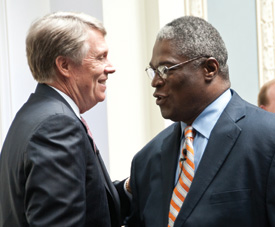
Testing Our Limits
In November 2009, KCP&L announced its SmartGrid Demonstration Project. This project is supported by a grant awarded by the Department of Energy (DOE) and matched by KCP&L and its project partners. This initiative encompasses most aspects considered to be part of a smart grid – smart generation, renewables, smart substations, smart distribution, smart buildings and smart customer end-use. The DOE is focusing a good deal of attention on interoperability and refinement of emerging smart grid standards through KCP&L’s $24 million SmartGrid Demonstration grant. As we are building a state-of-the-art system through this grant, KCP&L’s partnership with Google has enabled us to expand our horizons even further. The deployment of a distribution management system known in the utility industry today is at our SmartGrid Demonstration Project’s beginning, and Google Fiber will allow us to test the limits of real-time system reconfiguration. We have driven our engineers, project architects and vendors to think “outside the box;” this places our thinking “outside the universe.”
Today’s computers and servers are capable of manipulating and storing high volumes of data. However, these devices can only send and store the amount of data they are able to transmit. In other words, if the infrastructure is not there, the bandwidth is limiting. This is particularly true of a distribution system; if the size and speed of the infrastructure is behind the times, the information is not up to par. Can you imagine having gigabit speed available to any piece of distribution equipment – new or existing? It is no secret that the speed of fiber communications enables extremely fast fault detection. Having the ability to reconfigure the system and isolate the fault in nanoseconds before a breaker would trip in the first place is a concept we may try testing to see if it is applicable and beneficial to our system and customers.
If you think back to the IBM PC and then consider today’s Internet capabilities, mobile computing and wireless communications platforms, open standards have enabled a great deal of successful third-party development. Just a few years ago you could not buy an external computer device and connect it unless you inserted the accompanying CD first. Now your personal computer can recognize devices when they are simply plugged in. Currently, KCP&L’s SmartGrid focuses attention on developing industry standards as the utility industry is not yet to the “plug-and-play” world. Google has an understanding of what it takes to do this, and we intend to work with them to help utilities move quickly down this path.
Connecting with Customers
With all of the resources Google possesses, it is able to understand and influence customer behavior like electric utilities and other industries never have. Because of their experience with customer interaction, the ability for KCP&L to brainstorm possibilities with Google is truly exciting. Google is a company that touches millions of customers each second and is continuously finding new and innovative ways to communicate with their customers.
Collaborating with Google on bringing this ultra high-speed Internet service to the Kansas City region may dramatically accelerate KCP&L’s ability to educate, outreach and train customers on a variety of products and services. This could all start with our SmartGrid concepts and tools – using a combination of best practices from KCP&L and Google customer communications experience. Gigabit speed to customers will enhance these capabilities for utilities.
As an energy provider, we have an obligation to educate our customers on energy use, power creation and distribution as well as up-and-coming technology we see in our SmartGrid Demonstration Project. Educating our customers empowers them to make wiser and more informed decisions about their energy usage. Google is an expert in marketing, and marketing is a focused level of customer education.
Benefits of Bandwidth
KCP&L takes cyber security for our company and our customers seriously. To achieve our SmartGrid Demonstration Project’s full benefits, large amounts of data need to be available in multiple arenas that do not exist today. Protecting data from cyber attacks is essential to the success of a smart grid. Once again, partnering with Google could help move us forward more quickly than we could without ultra high-speed Internet service. Google understands the importance of delivering a highly reliable service, and any disruptions in service would affect public image, revenue and customer confidence for Google. Similarly, KCP&L focuses on customer satisfaction and stakeholder confidence in our system reliability and the value of the service we deliver for the price.
Another benefit of gigabit bandwidth is the ability to update software and firmware in field devices. We are all familiar with the cost of rolling a truck to update an intelligent device. Bandwidth continues to be a concern, even with today’s modern advanced metering infrastructure (AMI) systems. Even if equipment is capable of updating remotely, we tend to shy away or wait for larger upgrades to avoid “clogging the system” with non-essential data flows. If bandwidth is no longer an issue because of Google Fiber, applying patches should become significantly less of a concern.
Consequently, many of us are still waiting for a real Distribution Management System (DMS). Partnering our utility expertise, including vendors, with the ingenuity and creative horsepower of Google will bring data to system operators’ fingertips more quickly than ever envisioned. The possibilities abound: the graphical user interface (GUI) could become a touch screen capable of responding to voice commands; a single operator could perform at the productivity of multiple operators today, with a lower error rate; video chat between an operator and a crew truck becomes a day-to-day business practice.
Gigabit data can enable video monitoring that captures on-the-scene events. Engineers and troubleshooters can quickly place video equipment in service that can be triggered to retain rolling footage after an event. Imagine what could be learned if we are virtually present while an event occurs. This will be valuable for improving system reliability and equipment designs from an asset management perspective.
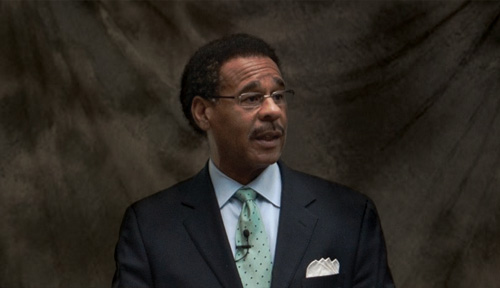
Missouri Congressman Emanuel Cleaver II thanks KCP&L for its involvement in not only the Google Fiber project, but also for KCP&L’s involvement in other innovative initiatives such as its SmartGrid Demonstration Project.
Where will Google Fiber take us? No one is quite sure yet. What we do know is that KCP&L has an opportunity to be a pioneer of this technology, finding uses that will benefit the business and our customers. As the United States was developing, pioneers found a connection point in Kansas City: the Sante Fe Trail, Oregon Trail and California Trail connect here in the heartland. Google Fiber will allow KCP&L to have an Internet service that will unlock countless benefits for the community. Companies will want to move here; our schools, businesses, neighborhoods and individual residents will see the advantages of the ultra-fast broadband technology.
We have a proud history of innovation and “firsts” in our industry, from our landmark carbon offset agreement with the Sierra Club, to our SmartGrid Demonstration Project, to the introduction of all-electric vehicles to our fleet. KCP&L will pioneer into the future with Google Fiber. Just as the move from dial-up to broadband led to new and unpredictable innovations, ultra high-speed bandwidth will push the web to even greater heights – and we couldn’t imagine a better place to start than the Kansas City region.
About the Authors
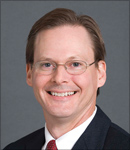
Steven Gilkey currently holds the position of Senior Director T&D Engineering & Planning at KCP&L. He has responsibility for all engineering functions in the transmission, distribution and substation areas of KCP&L. The delivery capital budget, transmission system operations and SmartGrid strategy also fall under his direction. Mr. Gilkey has been with KCP&L since 2003.
Steven began his utility career in 1985 as an Electrical Engineer at Niagara Mohawk Power Corporation. His industry experience includes engineering, field supervision, operations management, emergency response, merger and acquisition work and has progressed through leadership roles across upstate New York and the Mid-West. Steven earned his Bachelor’s Degree in Electrical Engineering from Syracuse University, and a Master’s Degree in Business Administration from Rensselaer Polytechnic Institute in Troy, New York. He has recently completed Executive Programs at the Massachusetts Institute of Technology (MIT) Sloan School of Management.
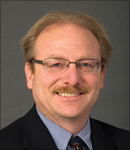
William Menge is KCP&L’s SmartGrid director. Key in his present responsibilities is leading a true end-to-end SmartGrid Demonstration Project spanning from smart/renewable generation through advanced automation in the distribution system, advanced metering infrastructure and into customer end-use applications, controls and programs. Prior to SmartGrid, he was Manager of Asset Management and oversaw completion of the T&D infrastructure improvement portfolios under KCP&L’s award winning Comprehensive Energy Plan.
William has been with KCP&L since 2006 and possesses 25 years experience in the power industry. His industry experience includes various engineering roles, construction management, construction quality assurance, transmission project management, distribution standards, operations and maintenance program management. William serves on the N.E. Johnson County (KS) Chamber of Commerce Board, the Kansas Smart Corridor Economic Development Board, NERC’s Smart Grid Task Force and received a BSEE from Bradley University.







